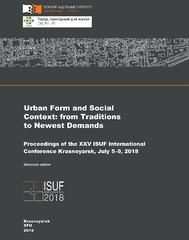Приказ основних података о документу
Department store’s role in modernization and “demodernization” of city centers in ex-Yugoslavia
| dc.creator | Djokic, Vladan | |
| dc.creator | Djordjevic, Aleksandra | |
| dc.creator | Zoric, Ana | |
| dc.date.accessioned | 2023-11-26T21:03:02Z | |
| dc.date.available | 2023-11-26T21:03:02Z | |
| dc.date.issued | 2019 | |
| dc.identifier.isbn | 978-5-7638-4127-5 | |
| dc.identifier.uri | https://raf.arh.bg.ac.rs/handle/123456789/1662 | |
| dc.description.abstract | The period between 1966 and 1995 is characterized by a constant need for the modernization of society and cities. Department store, introduced as a Western economic model of consumer culture, was established in Yugoslavia after the 1960’s economic reform. This typology had great influence on the market and consumer society in Yugoslavia but had also changed the image and the way central areas in the former Yugoslavia functioned. This paper has two goals. On one hand, it should examine the influence of consumerism in the socialist society of Yugoslavia on the positioning, function, design and construction of the “Belgrade” Department Stores buildings. On the other hand, we believe that the politics of consumer society, mass production and consumerism, integrated into the objects of department stores, significantly influenced the planning and design of city development which can be followed through morphogenic approach. Today, “Belgrade” department stores, built in more than 30 cities with 44 buildings in total, cannot satisfy newest demands in shopping and trade, remain as such in central positions, but with marginalized function. They cannot be perceived only as an economic model, as it was done during the 2009 reconstruction, since this approach cannot provide an adequate solution for reuse, nor can their meaning be understood in the history of city development. These buildings have been printed on postcards, and as such presented a symbol of modernization and tradition, as well as a hallmark of a time and ideology that is still insufficiently known. Research on department store’s previous role in modernization and today’s unfortunate contribution to demodernization of city centers can not only help establish a different approach in a contemporary design and reconstruction but can also address the need to bring them back the significance that they had for society and city or give them new one. | sr |
| dc.language.iso | en | sr |
| dc.publisher | Krasnoyarsk: Siberian Federal University | sr |
| dc.relation | info:eu-repo/grantAgreement/MESTD/Technological Development (TD or TR)/36035/RS// | sr |
| dc.rights | openAccess | sr |
| dc.source | Urban Form and Social Context: from Traditions to Newest Demands : proceedings of the XXV ISUF International Conference, Krasnoyarsk, July 5–9, 2018 | sr |
| dc.subject | department stores | sr |
| dc.subject | Yugoslavia | sr |
| dc.subject | morphogenesis | sr |
| dc.subject | modernization | sr |
| dc.subject | demodernization | sr |
| dc.title | Department store’s role in modernization and “demodernization” of city centers in ex-Yugoslavia | sr |
| dc.type | conferenceObject | sr |
| dc.rights.license | ARR | sr |
| dc.citation.spage | 230 | |
| dc.citation.epage | 239 | |
| dc.identifier.fulltext | http://raf.arh.bg.ac.rs/bitstream/id/5248/bitstream_5248.pdf | |
| dc.identifier.rcub | https://hdl.handle.net/21.15107/rcub_raf_1662 | |
| dc.type.version | publishedVersion | sr |

